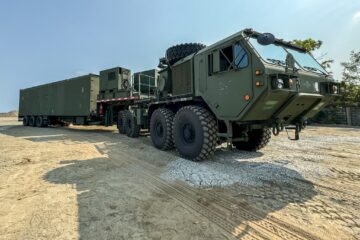The test took place on 1 December at the Pacific test range as the destroyer was assigned to Carrier Strike Group ONE with aircraft carrier USS Carl Vinson (CVN 70).
The Pacific Missile Range Facility, Barking Sands is a U.S. naval facility and airport located near Kekaha, in Kauai County, Hawaii, United States.

All Tomahawk Block IVs are being upgraded to Block V with longer range and dynamic targeting with the capability to hit vessels at sea (maritime strike role). Raytheon is recertifying and modernizing the missile, extending its service life by 15 years, and resulting in the new Tomahawk Block V series:
- Block V: A modernized TACTOM with upgraded navigation and communication
- Block Va: Block V that can strike moving targets at sea
- Block Vb:Block V, with a joint multi-effects warhead that can hit more diverse land targets
The Tomahawk IV – known in the Royal Navy as TLAM (Tomahawk Land Attack Cruise Missile) – allows submarines and surface vessels to strike at ground targets hundreds of miles inland with pinpoint accuracy. Tomahawk IV has a longer range than its predecessors (well in excess of 1,000 miles), can be directed at a new target in mid-flight, and can also beam back images of the battlefield to its mother submarine.
According to Raytheon, U.S. and allied militaries have flight-tested the GPS-enabled Tomahawk 550 times and used it in combat more than 2,300 times. Its most recent use came in 2018, when U.S. Navy warships and submarines launched 66 Tomahawk missiles at Syrian chemical weapon facilities.
Update
Raytheon issued the following press release about this first firing:
The U.S. Navy and Raytheon Missiles & Defense, a Raytheon Technologies business, successfully completed two flight tests with the franchise’s newest cruise missile variant, the Tomahawk Block V. During the tests, the USS Chafee (DDG 90) launched two Block V missiles, impacting targets at ranges on both San Nicolas Island and Naval Air Weapons Station China Lake in California.
Tomahawk is a highly accurate, GPS-enabled missile that can fly into heavily defended airspace and conduct precise strikes on high-value targets with minimal collateral damage. The advanced Tomahawk Block V includes improved navigation and communications.
“These tests keep the Navy on schedule to introduce Block V into the fleet next year,” said Kim Ernzen, vice president of Naval Power at Raytheon Missiles & Defense. “Our modernization and recertification efforts will also extend the missile’s service life by 15 years.”
During the tests, the missiles were redirected mid-flight to different targets using their new advanced communications architecture systems.
“The Block V capabilities reinforce Tomahawk’s unequivocal role as the Navy’s long-range strike weapon far into the future,” said Capt. John Red, the Navy’s Tomahawk Weapons System program manager. “These tests are tremendous milestones for our teams that have been working on these improvements for several years.”
Additional Block V enhancements, such as a maritime strike capability (Block Va) and a programmable warhead for an expanded land attack capability (Block Vb), are in development for future deliveries. Block Va will strike moving targets at sea, while Block Vb will defeat a more diverse range of land targets.






